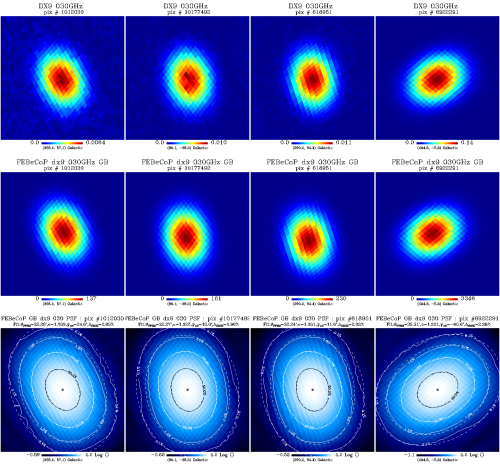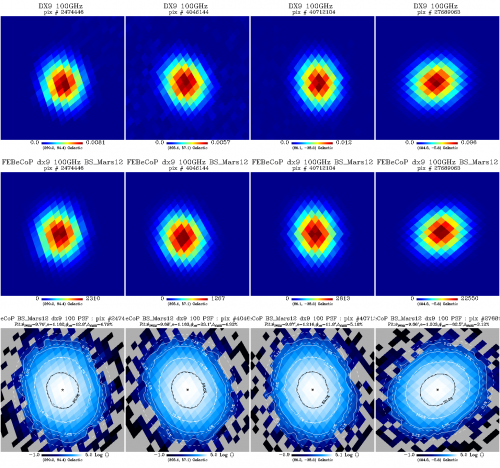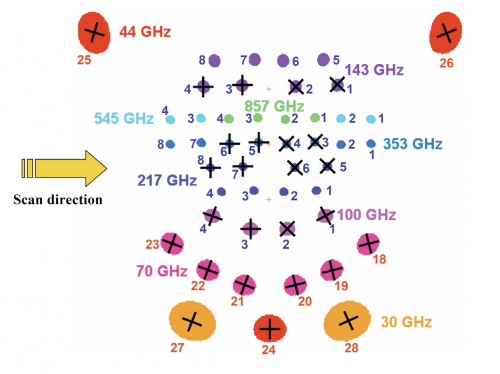Effective Beams
The second part of this section is mostly unreadable. Please use proper style in terms of sectioning (i.e. pseudo headings that are underlined), lists (bullet or numbered) - see other pages for examples. Info regarding M3 (and NERCS) is probably irrelevant to external users)
Contents
Product description[edit]
The effective beam is the average of all scanning beams pointing at a certain direction within a given pixel of the sky map for a given scan strategy. It takes into account the coupling between azimuthal asymmetry of the beam and the uneven distribution of scanning angles across the sky. It captures the complete information about the difference between the true and observed image of the sky. They are, by definition, the objects whose convolution with the true CMB sky produce the observed sky map.
The effective beam is computed by stacking within a small field around each pixel of the HEALPix sky map. Due to the particular features of Planck scanning strategy coupled to the beam asymmetries in the focal plane, and data processing of the bolometer and radiometer TOIs, the resulting Planck effective beams vary over the sky.
Comparison of the images of compact sources observed by Planck with FEBeCoP products
We show here a comparison of the FEBeCoP derived effective beams, and associated point spread functions,PSF (the transpose of the beam matrix), to the actual images of a few compact sources observed by Planck, for 30GHz and 100GHz frequency channels. We show below a few panels of source images organized as follows:
- Row #1- DX9 images of four ERCSC objects with their galactic (l,b) coordinates shown under the color bar
- Row #2- linear scale FEBeCoP PSFs computed using input scanning beams, Grasp Beams, GB, for LFI and B-Spline beams,BS, Mars12 apodized for the CMB channels and the BS Mars12 for the sub-mm channels, for HFI (see section Inputs below).
- Row #3- log scale of #2; PSF iso-contours shown in solid line, elliptical Gaussian fit iso-contours shown in broken line
- 30 GHz
- 100 Ghz '
Statistics of the effective beams computed using FEBeCoP for 100-857 GHz channels
We tabulate the simple statistics of FWHM, ellipticity, orientation and beam solid angle for a sample of 3072 directions on the sky. Statistics shown in the Table are derived from the histograms shown below.
| frequency | mean(fwhm) [arcmin] | sd(fwhm) [arcmin] | mean(e) | sd(e) | mean(psi) [degree] | sd(psi) [degree] | mean(Solid Angle) [arcmin'] | sd(Solid Angle) [arcmin'] |
|---|---|---|---|---|---|---|---|---|
| 100 | 9.651 | 0.014 | 1.186 | 0.023 | -0.024 | 55.400 | 105.778 | 0.311 |
| 143 | 7.248 | 0.015 | 1.036 | 0.009 | 0.383 | 54.130 | 59.954 | 0.246 |
| 217 | 4.990 | 0.025 | 1.177 | 0.030 | 0.836 | 54.999 | 28.447 | 0.271 |
| 353 | 4.818 | 0.024 | 1.147 | 0.028 | 0.655 | 54.745 | 26.714 | 0.250 |
| 545 | 4.682 | 0.044 | 1.161 | 0.036 | 0.544 | 54.876 | 26.535 | 0.339 |
| 857 | 4.325 | 0.055 | 1.393 | 0.076 | 0.876 | 54.779 | 24.244 | 0.193 |
FEBeCoP deliverables
- The derived beam parameters are representative of the DPC NSIDE 2048 healpix maps (they include the pixel window function).
- The reported FHWM are derived from the solid angles, under a Gaussian approximation. The value in the values in parenthesis are the Gaussian fits to the effective beam maps tabulated above. The former is best used for flux determination, the latter for source identification.
| Band | Omega_beam [arcmin] | Monte Carlo error[arcmin^] | spatial variation [arcmin] | bias [arcmin] | FWHM_eff (Gaussian fit) [arcmin] |
| 100 | 105.78 | --- | 0.31 | --- | 9.66 (9.65) |
| 143 | 59.95 | --- | 0.25 | --- | 7.27 (7.25) |
| 217 | 28.45 | --- | 0.27 | --- | 5.01 (4.99) |
| 353 | 26.71 | --- | 0.25 | --- | 4.86 (4.82) |
| 545 | 26.54 | --- | 0.34 | --- | 4.84 (4.68) |
| 857 | 24.24 | --- | 0.19 | --- | 4.63 (4.33) |
Beam solid angles for the PCCS
- Omega_beam - is the mean beam solid angle of the effective beam, where beam solid angle is estimated according to the definition: 4pi/sum(effbeam)/max(effbeam), i.e. as an integral over the full extent of the effective beam
- from Omega_beam we estimate the fwhm_eff, under a Gaussian approximation - these are tabulated above
- Omega_beam_1 is the beam solid angle estimated up to a radius equal to 1xfwhm_eff and Omega_beam_2 up to a radius equal to 2xfwhm_eff
- These were estimated according to the procedure followed in the aperture photometry code for the PCCS: if the pixel centre does not lie within the given radius it is not included (so inclusive=0 in query disc).
| Band | Omega_beam[arcmin] | spatial variation [arcmin] | Omega_beam_1 [arcmin] | spatial variation-1 [arcmin] | Omega_beam_2 [arcmin] | spatial variation-2 [arcmin] |
| 100 | 105.778 | 0.311 | 100.830 | 0.410 | 105.777 | 0.311 |
| 143 | 59.954 | 0.246 | 56.811 | 0.419 | 59.952 | 0.246 |
| 217 | 28.447 | 0.271 | 26.442 | 0.537 | 28.426 | 0.271 |
| 353 | 26.714 | 0.250 | 24.827 | 0.435 | 26.653 | 0.250 |
| 545 | 26.535 | 0.339 | 24.287 | 0.455 | 26.302 | 0.337 |
| 857 | 24.244 | 0.193 | 22.646 | 0.263 | 23.985 | 0.191 |
Production process[edit]
The methodology for computing effective beams for a scanning CMB experiment like Planck
was presented in our [| paper].
FEBeCoP, or Fast Effective Beam Convolution in Pixel space, is an approach to representing and computing effective beams (including both intrinsic beam shapes and the effects of scanning) that comprises the following steps:
- identify the individual detectors' instantaneous optical response function (presently we use elliptical Gaussian fits of Planck beams from observations of planets; eventually, an arbitrary mathematical representation of the beam can be used on input)
- follow exactly the Planck scanning, and project the intrinsic beam on the sky at each actual sampling position
- project instantaneous beams onto the pixelized map over a small region (typically <2.5 FWHM diameter)
- add up all beams that cross the same pixel and its vicinity over the observing period of interest
- create a data object of all beams pointed at all N'_pix_' directions of pixels in the map at a resolution at which this precomputation was executed (dimension N'_pix_' x a few hundred)
- use the resulting beam object for very fast convolution of all sky signals with the effective optical response of the observing mission
Inputs[edit]
In order to fix the convention of presentation of the scanning and effective beams, we show the classic view of the Planck focal plane as seen by the incoming CMB photon. The scan direction is marked, and the toward the center of the focal plane is at the 85 deg angle w.r.t spin axis pointing upward in the picture.
A list (and brief description to the extent possible) of the input data used to generate this product (down to file names), as well as any external ancillary data sets which were used.
- Detector pointings:
- Intrinsic beam description:
- Beam cutoff radius: 2.25 times geometric mean of FWHM of all detectors in a channel
- map resolution for the derived beam data object:
- N'_side_' = 1024 for 100GHz
- N'_side_' = 2048 for all other frequencies
Related products[edit]
A description of other products that are related and share some commonalities with the product being described here. E.g. if the description is of a generic product (e.g. frequency maps), all the products falling into that type should be listed and referenced.
Effective beams are located at nersc: ??
and in both the HFI and LFI DPCs at:
- On disk: /space/SimuData/effBeam_HFI_v41
- DMC group: /data/dmc/MISS01/DATA/FEBeCoP_v41
Interface modules were developed to easily access the beams and the PSFs from the disk and the database. For HFI: The codes for reading the beams/PSFs and demonstration programs (http://cvs.planck.fr/cvs/Level2/Task_pkg/HL2_FEBeCoP/) FOr LFI:
The interface contains Fortran 90 routines to read the beams either from disk or from database. There are IDL routines also to read the beams from disk with detailed inbuilt help and fast examples.
There are two sets of (serial) demonstration programs:
- to extract beams/PSF at any given set of pixels from disk/database and make .fits skymaps
- beam_extract_f : extract beams from disk
- beam_extract_f_PIO: extract beams from database
- psf_extract_f : extract PSF from disk
- psf_extract_f_PIO : extract PSF from database
- to make a full sky convolution of input maps with effective beams
- effConv : convolve map reading beam from disk
- effConv_PIO : convolve map reading beam from database
Example parameter files (with explanation) for these demonstration programs are available here: http://cvs.planck.fr/cvs/Level2/Task_pkg/HL2_FEBeCoP/params/
A detailed README on the usage of the routines and the programs are available as: http://cvs.planck.fr/cvs/Level2/Task_pkg/HL2_FEBeCoP/README.txt included here:
- HFI
How to use FEBeCoP effective beams and PSFs on magiqueIII
Is this of any relevance? external users don't use M3
The methodology for computing effective beams for a scanning CMB experiment like Planck was presented in our paper: http://arxiv.org/pdf/1005.1929
For easy access to the FEBeCoP beams and PSFs computed on NERSC, they have been transferred to magiqueIII. They are currently stored at two locations:
1. Hard disk: /space/SimuData/effBeam_HFI_v41 2. DMC group: /data/dmc/MISS01/DATA/FEBeCoP_v41
The gory details of how binary data is organized in the files / DMC objects are not essential to the user and may also change in the future. Here we present how the FEBeCoP I/O interface (installed and tested on magiqueIII) can be used to read effective beams and PSFs for any given set of pixels.
I/O routines to read effective beams are in:
http://cvs.planck.fr/cvs/Level2/Task_pkg/HL2_FEBeCoP/src/util/
At present, the Fortran routines are available as .f90 sources, they will be available as a compiled library in future. getBeam.f90 can be used read beams from the disk and getBeam_PIO.f90 to read from the database.
Example Fortran programs and Makefiles to load beams/PSFs either from disk or from database and make their .fits skymaps are in:
http://cvs.planck.fr/cvs/Level2/Task_pkg/HL2_FEBeCoP/src/beam_extract_f/ and http://cvs.planck.fr/cvs/Level2/Task_pkg/HL2_FEBeCoP/src/psf_extract_f/
There are two test programs to make full sky effective beam convolved maps, reading beams either from disk or from database, in:
http://cvs.planck.fr/cvs/Level2/Task_pkg/HL2_FEBeCoP/src/convolve/
List of programs
beam_extract_f : extract beams from disk beam_extract_f_PIO : extract beams from database psf_extract_f : extract PSF from disk psf_extract_f_PIO : extract PSF from database effConv : convolve map reading beam from disk effConv_PIO : convolve map reading beam from database
Example parameter files with brief explanations are provided in: http://cvs.planck.fr/cvs/Level2/Task_pkg/HL2_FEBeCoP/params/
The IDL routines (beaminit.pro and getbeam.pro/getpsf.pro) can be used to read the beams/PSFs from disk. These routines have detailed inbuilt help with easy to use examples.
Details on the subroutines
(Please look at the appropriate routines to get the exact syntax)
The basic scheme to load the beams/PSFs (in Fortran or IDL) has two steps:
1. Init
function: "beaminit"
arguments:
"beaminfo" (output of this routine, users need not worry about this)
"prefix" is the prefix to the beam files or DMC objects, e.g., for 100GHz beams
from disk: prefix=/data/smitra/effBeam_HFI_v41/100/beams_
from DMC: prefix=/data/dmc/MISS01/DATA/FEBeCoP_v41/100_
2. Read beams/PSFs
function: "readbeam"/"readpsf"
arguments:
"beam"/"psf" structure describes beams/PSFs using the following elements:
pix : (int_32) pixel index of the beam centre
nlist : (int_32) number of pixels used to describe the beam (typically ~200)
listpix : (nlist int_32) list of pixel indices describing the beam
map : (nlist or 6 x nlist float_32) values at the pixels listed in listpix
nobs : (1 or 6 float_64) effective number of observation matrix
"beaminfo" (output of beaminit, no need to worry about this)
"pixlist" is the list of pixels for which beam should be loaded
"npixel" number of pixels for which beam should be loaded
File Names[edit]
Meta data[edit]
A detailed description of the data format of each file, including header keywords for fits files, extension names, column names, formats….
Cosmic Microwave background
(Hierarchical Equal Area isoLatitude Pixelation of a sphere, <ref name="Template:Gorski2005">HEALPix: A Framework for High-Resolution Discretization and Fast Analysis of Data Distributed on the Sphere, K. M. Górski, E. Hivon, A. J. Banday, B. D. Wandelt, F. K. Hansen, M. Reinecke, M. Bartelmann, ApJ, 622, 759-771, (2005).
Early Release Compact Source Catalog
(Planck) Low Frequency Instrument
(Planck) High Frequency Instrument
Full-Width-at-Half-Maximum
Data Processing Center
Data Management Component, the databases used at the HFI and LFI DPCs


